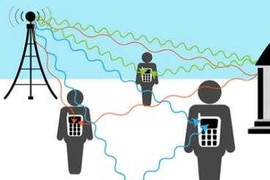Your smartphone’s communications degrade when the device competes with other mobile traffic to send and receive data, and that competition will only intensify. Far more than a billion smartphones are expected to ship this year. Additional wireless traffic is pouring in from tablets, and more will come from "Internet of Things" devices, car-to-car communications, and other sources.
Wireless spectrum, however, remains scarce and expensive. The U.S. Federal Communications Commission, for example, has raised $60 billion since 1994 by auctioning off cellular spectrum. For years, wireless providers have extended the reach of their networks within existing frequencies by various means.
One strategy that has gained popularity in the last decade is to add small cell base stations, also known as femtocells or picocells, in places with high traffic density such as inside buildings or in densely populated urban neighborhoods. These lower-powered versions of wireless macro cell towers can fill gaps in coverage in these high-density locations, using the same frequency bands and hooked to the cellular network via landline. Business customers now are also installing small cell base stations at a rapidly accelerating pace, and this arrangement is backed by operators ranging from AT&T to Korea’s SK Telecom. Informa Telecoms and Media estimates that the market for small cell base systems will reach $22 billion by 2016.
This blizzard of base stations, however, can interfere with operation of towers and with each other, boosting the numbers of degraded connections and calls that are dropped or never connected. “As you put more small cells out there, you are also putting out a lot of little interfering signals, and today’s devices can’t handle all that noise adding up and getting in the way of the signals they want to hear,” says Rachel Learned, a researcher at MIT’s Lincoln Laboratory. “We want to get past that.”
Cognitive coexisting radio (CCR) technology developed by Learned and her colleagues helps to overcome interference problems by intelligently exploiting the spectrum already in use for other transmissions, dramatically boosting connections while living comfortably side by side with those existing transmissions. Moreover, the CCR approach can be added to existing off-the-shelf wireless components, and it doesn’t require changes to existing wireless infrastructure, active management by the small base station operator, or collaboration with other users of the spectrum.
A number of other new MIT technologies address challenges in wireless spectrum use. “Everything in high-speed networks is about how you deal with interference,” notes Dina Katabi, professor of electrical engineering and computer science and head of the MIT Center for Wireless Networks and Mobile Computing.
Solving base station spectrum scarcity
Several other approaches to get more use from existing wireless spectrum for small cell base stations have been adopted, but they pose significant drawbacks that CCR does not.
In one approach, operators can avoid interference by allocating part of their spectrum to each small base station, but that prevents them from using that band in a macro tower station that handles many more users and generates revenue.
Another more popular way to reduce interference is to make the small cells “public” so that they support traffic from any local user. For instance, when a FedEx driver passes a building with a small cell base station, the driver’s phone call can be carried via that station. Almost three-quarters of small cell base stations installed by network operators are public. However, business customers aren’t happy about making their private systems public, because they end up paying for nearby outsiders to piggyback on their systems, thereby degrading performance for their own users, increasing levels and duration of signal exposure to their building occupants, and adding security concerns.
A third commonly adopted technique is to divide available spectrum among all transmitters in a given area by allotting time/frequency slots available to the operator. However, Learned points out that this is hard to coordinate among station operators. If that coordination isn’t practical, the small base can’t respond flexibly to spectrum demand, and instead gives up large slots of times or frequencies or both.
With another proposed technique, a cognitive radio variant called opportunistic interference avoidance, the base station monitors other calls and adaptively uses frequencies that are not being used at that moment. But during peak times when demand is high, there are no idle frequencies available. Even in non-peak times, as more wireless devices and small cell base stations are installed, the availability of such frequencies will plummet.
In contrast to all of these approaches, CCR purposely locates its transmissions on the same band that another receiver/transmitter pair is already using, Learned says. Built on a cognitive engine, CCR watches and actively exploits occupied channels, intelligently and adaptively manipulating interference to create new links without significantly degrading existing links or requiring negotiation with other station operators.
“The CCR system monitors the power and the rates of the other transmitters to understand their use of the spectrum,” she explains. “It predicts when its presence is likely to cause little harm, then makes use of the channels occupied by likely oblivious links, all while watching to see if the existing link adapts too much. If the other users react too much, it can play nice, by going away or reducing its power. If they react just a little, the system will conclude that it’s okay to coexist with these links.”
“The system also has a learning capability that can improve the prediction over time and reducing the chance of causing problems,” Learned says. “So it has a pretty good chance of not hurting any of the existing macro or small cells, all the while providing additional high-throughput small cell links without needing more spectrum.”
“Basically it’s like when you walk down a sidewalk and someone’s in front of you,” she adds. “You do that little dance for a second and then you figure it out and pass each other. You don’t have to talk to each other but you do have a little impact on each other. After a few encounters, you even learn the customary side to favor, and may have to do the dance less often as you travel the sidewalk. So that’s what your phone does with CCR — it does the sidewalk dance with other phones.”
The advantages of this approach are increased throughput and the ability to initiate and maintain calls, says Learned, with benefits that depend on each specific situation. One simulation that examined how users of a small cell base station would be affected by a passerby’s smartphone, for example, showed the ability to maintain five links simultaneously instead of one.
CCR will also help in situations where customers want to keep their small cell base stations private. In that situation, nearby users whose phones are linked to the nearest cell phone tower rather than the small base system may interfere with all of the frequencies that the small base station is trying to use — unless the small cell base station is equipped with CCR.
Importantly, manufacturers of base stations can exploit these CCR advantages with standard existing technologies and protocols, Learned emphasizes. Additionally, CCR systems can play an important role in disaster response, helping to ensure reliable communications among emergency radio equipment of all kinds.
Widening the spectrum
Other MIT efforts to optimize the use of wireless spectrum include a cognitive radio technology that weaves together available frequencies and technologies that aim to improve network performance via smart antennas.
Katabi’s group developed SWIFT (Split Wideband Interferer Friendly Technology), a “cognitive aggregation” radio technology designed to let high-throughput network nodes efficiently coexist with unknown low-throughput devices. “SWIFT can detect the bandwidth of use by others in the spectrum, and it can weave the bandwidth available together so that it can get a very wide spectrum,” she says. “If there are holes in the spectrum that are used by other people, it doesn’t interfere with them and it still gets very high data rates.”
Other MIT programs look at methods to achieve five to 10 times higher data rates under certain conditions using smart antenna technology, in ways that could aid small cell base stations as well as other wireless systems, Katabi says.
One technology called MegaMIMO synchronizes network-independent access points so that they can communicate with their clients on the same wireless channel as if they were a single large multiple-input and multiple-output (MIMO) transmitter, thus permitting wireless networks to smoothly scale up their throughput by adding independent access points on the same channel. A related technology, OpenRF, aims to let access points on the same wireless channel each target signals at their own clients more tightly and cancel their interference at other clients.
MIT researchers also have engineered several wireless multi-user detection schemes that can help to enable CCR or can be used on their own.
Additionally, Katabi and colleagues have developed an algorithm that can efficiently handle high bandwidth data 10 or more times faster than the conventional Fast Fourier Transform (FFT). Sparse Fast Fourier Transform (sFFT) is expected to find many applications on cellular networks, including analyzing available spectrum and compressing large video files for transmission.
All these MIT technologies may aid in making good connections among smartphones and other devices as the global population of small cell base stations soars, from 11 million in 2013 to 92 million in 2016, by Informa estimates.
“Everyone wants to use the cellular network,” says Afarin Bellisario, MIT technology licensing officer. “People are mobile and increasingly urban, the Internet of Things is arriving to create smart cities and smart highways, and it all consumes bandwidth. With people increasingly living, working, or taking trains in very close proximity, we need an enabling and robust wireless infrastructure.”









